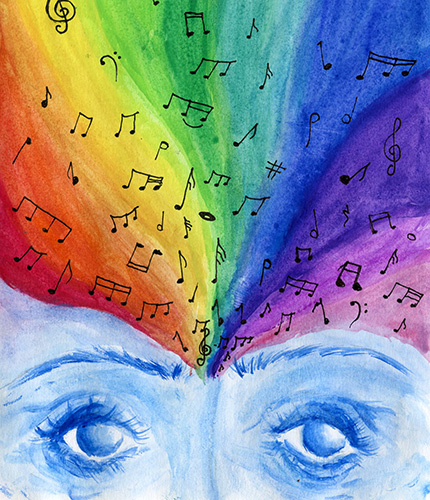Students with synesthesia see sounds at South

Illustration by Faith Roche
December 20, 2019
Imagine if temperatures made noise, voices had their own scent or numbers flaunted their own unique personalities. Inside the mind of someone with synesthesia, intriguing mixtures of senses like these are a reality. Live Science, a science news website, describes synesthesia as “a neurological condition that causes the brain to process data in the form of several senses at once,” and it can manifest in many ways. Junior Rachel Rochlen said she experiences a variety of these wonders.
“I experience it mainly through color,” Rochlen explained. “I see colors when I listen to music, smell [or] eat something, or when I touch someone or [when] someone touches me. My letters and numbers have colors. [So do] words, sentences, days of the week, months and people.”
Like Rochlen, senior Anya Cronin’s senses are similarly intermixed. According to Cronin, she experiences synesthesia through a correlation of colors and music.
“I see colors, different movements, and patterns in my mind and it happens a lot when I’m focused on a song or if I really enjoy it,” Cronin said. “I associate personalities with numbers and colors.”
Cronin believes that synesthesia has helped boost her creativity. Cronin explained how she exhibits her unique thought process through more tangible forms of art.
“I draw and I paint, [and] I used to paint songs so I would just paint what I see,” Cronin said. “I think it has enhanced my artistic abilities and [helped me] cross boundaries with my artistic skills. So, I am not just painting what I see in real life, [I’m painting what I see] in my mind.”
Rochlen described how she can use her synesthesia to create music; in her mind, every note, chord, and key has its own individual color. Rochlen explained how this correlation helped her achieve perfect pitch, the rare musical ability to identify or recreate tones. For instance, Rochlen shared that if she hears a note that is a certain shade of red, she knows that note is ‘C.’
“When I make music I start with a chord progression of the colors I see in my head,” Rochlen explained. “[For example,] if I want a certain song to be yellow or blue, I’ll figure out the chords that go with those colors. The words I choose for the song also correspond with how I want the colors to be.”
Rochlen noted how heightened creativity is a clear benefit of this condition; however, her synesthesia can often present challenges. While her synesthesia has lessened over time, Rochlen said she used to experience over fifty examples of synesthesia that hindered her school work.
“It interfered with my life so much,” Rochlen said. “It felt like when I was doing my schoolwork it was just yelling at me.”
On the contrary, senior Julia Holmblad believes synesthesia aids her memory and schoolwork. In math class, her association of numbers to colors helps her retain certain formulas and has also prompted some of her creative ideas in Humanities class, Holmblad said.
“In Humanities, we have a mind book, and we can write down whatever thoughts are going through our head at that moment, and this is something I have been wanting to do a piece about,” Holmblad stated. “[I want] to put down splashes of colors and then write what they correlate to.”
Holmblad explained that having synesthesia provides many benefits to her everyday life. Not only does it perpetuate her creative tendencies, but synesthesia also provides her with a means to express her identity.
“Overall, I am just happy to be able to talk with people about it,” Holmblad explained. “It is another conversation point and a cool part of who I am.”


